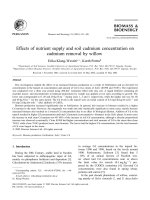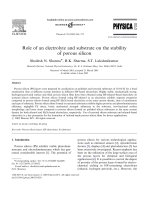Effects of stocking density and substrate pres
Bạn đang xem bản rút gọn của tài liệu. Xem và tải ngay bản đầy đủ của tài liệu tại đây (109.82 KB, 1 trang )
Nilnaj Chaitanawisuti, Anutr Kritsanapuntu, 1998. Effects of stocking density and
substrate presence on growth and survival of juvenile spotted babylon, Babylonia
areolata link 1807 (Neogastropoda: Buccinidae). Oceanographic Literature Review.
9(45):1682.
Abstract
Effects of stocking density and substrate presence on the growth and survival of
juvenile spotted babylon, Babylonia areolata, were assessed over a period of 180
days. Juveniles, with an average shell length of 15.0 ± 0.4 mm (n = 25), were held
in 1.0 x 1.0 x 0.8 ]m flow-through rearing tanks supplied with filtered (1 μm pore
size) aerated seawater at a rate of 5 L/min. Juveniles were divided into four
stocking densities at 50, 100, 150, and 200 individuals/m2 with sand substrate or no
sand substrate in the rearing tank. Juveniles were fed to satiation twice daily with
fresh carangid fish, Selaroides leptolepis. The results showed that absolute growth
rates in shell length and body weight of juveniles reared with sand were
significantly (p < 0.05) higher than those without sand, but no significant
differences were found among the densities. Average length increment ranged from
3.3 to 3.8 and 2.1 to 2.7 mm/mo for sand and no sand substrate, respectively.
Mortality during the experiment, at all densities, was negligible. Mean survival
ranged from 92 to 100% and 83 to 95% for sand and no sand substrate,
respectively. It may be concluded that growth, in both shell length and body
weight, and survival of juvenile B. areolata are considerably affected by the
presence of substrate, but not by stocking density (up to 200 individuals per m2).









